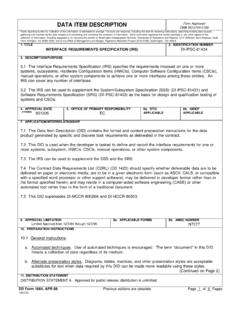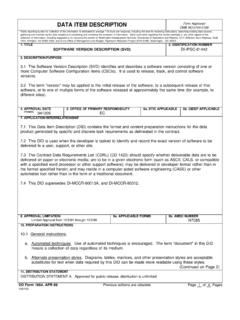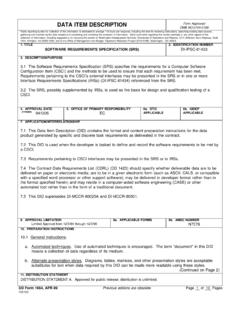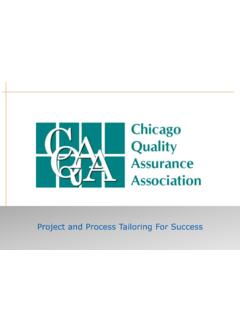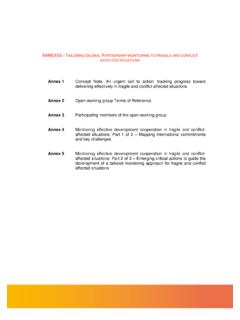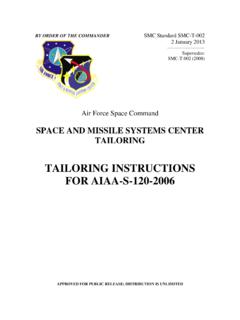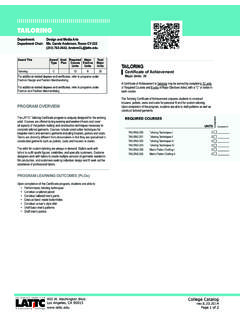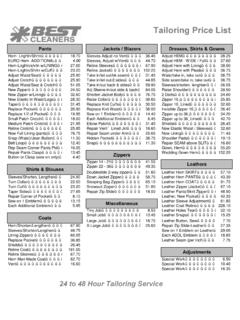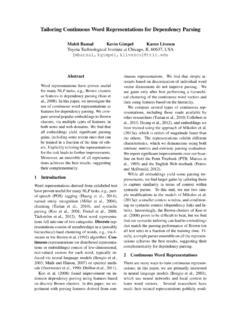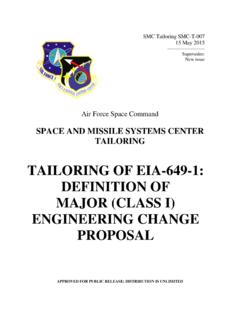Transcription of MIL-STD-498 Overview & Tailoring Guidebook 31 Jan 1996 ...
1 MIL-STD-498 Overview and Tailoring GUIDEBOOKMIL-STD-498 Software Development and DocumentationOVERVIEW ANDTAILORINGAPPLICATION AND REFERENCE31 JANUARY 1996 Joint Logistics CommandersJoint Policy Coordinating Groupon Computer Resources Management(PDF version) MIL-STD-498 Overview and Tailoring GuidebookPage iiThis page is intentionally blank.(PDF version) MIL-STD-498 Overview and Tailoring GuidebookPage iiiCONTENTSP aragraphPageFOREWORD ..viiEXECUTIVE Overview ..viiiPARTICIPANTS .. of the Guidebook .. on contracts .. of the Guidebook .. MENTIONED IN THIS Guidebook .. , standards, and handbooks .. government documents, drawings, and publications .. , Overview , KEY CONCEPTS, AND of MIL-STD-498 .. DOD-STD-2167A and DOD-STD-7935A .. issues identified in applying DOD-STD-2167A .. compatibility with current DoD instructions, standards, of of of MIL-STD-498 's general requirements.
2 Of MIL-STD-498 's detailed requirements .. of the MIL-STD-498 DIDs .. concepts of MIL-STD-498 .. and agreements assumed by MIL-STD-498 .. Incremental and Evolutionary development .. to formal reviews and audits .. emphasis on documentation and greater compatibility withCASE tools .. links to systems of software management indicators .. coverage of modification, reuse, and reengineering .. emphasis on software distinction between requirements and design .. with non-hierarchical coverage of database development .. criteria for software product evaluations .. 33(PDF version) MIL-STD-498 Overview and Tailoring GuidebookPage between software quality assurance and softwareproduct evaluation .. of configuration management to in-process work products .. to other related the software via the CDRL (DD Form 1423) .. importance of plans .. to MIL-STD-498 from DOD-STD-2167A and DOD-STD-7935A.
3 AND APPLICATION GUIDANCE .. of of applying MIL-STD-498 .. about is Tailoring .. tailor .. is Tailoring performs Tailoring .. and applying 1: Determining the context of the software development .. 2: Determining the program strategy for the system .. 3: Selecting a strategy for acquiring the software .. 4: Selecting the software support concept .. 5: Identifying types of software on the 6: Defining the software builds .. 7: Tailoring MIL-STD-498 for each build .. 8: Tailoring the DIDs as activity checklists .. 9: Recording Tailoring decisions in the Statement of Work .. 10: Clarifying "shell requirements".. 11: Selecting deliverables .. 12: Tailoring the DIDs for deliverables .. 13: Selecting the format of deliverables .. 14: Scheduling deliverables .. 15: Preparing the CDRL (DD Form 1423) .. 16: Including SDP preparation in Instructions to Bidders.
4 17: Evaluating Software Development Plans .. 18: Monitoring contract 736. NOTES .. 75 APPENDIXESA ppendixPageAList of 76 BMapping Between DOD-STD-2168 AND MIL-STD-498 .. 78 CSample Build Planning and Tailoring 81 Index ..100(PDF version) MIL-STD-498 Overview and Tailoring GuidebookPage vFIGURESF igurePage1 Objectives of MIL-STD-498 .. 92 Issues identified in applying 103 The MIL-STD-498 package .. 124 Organization of MIL-STD-498 .. 125 Overview of MIL-STD-498 's general 136 Overview of MIL-STD-498 's detailed requirements .. 147 The MIL-STD-498 188 Overview of MIL-STD-498 DIDs and the resulting software products .. 199 Players and agreements assumed by 2210 One possible mapping of MIL-STD-498 activities to multiple builds .. 2411 Excessive documentation .. 2512 Role of DIDs and software products in 2613 Two types of systems handled by 2714 Illustration of the use of quantitative measures.
5 2715 MIL-STD-498 provisions supporting modification, reuse, and reengineering .. 2816 MIL-STD-498 provisions that promote software supportability .. 2917 Contrasting definitions of requirements and design .. 3018 Flexibility in handling design entities, code entities, and 3119 Methodology independence of 3220 Relationship of the terms software, computer program, andcomputer database .. 3221 MIL-STD-498 's use of objective and subjective 3322 Avoiding overlap of SQA with other evaluation/testing activities .. 3423 Tiering of standards .. 3524 The MIL-STD-498 plans .. 3625 Mapping of key 3726 Mapping of DOD-STD-7935A DIDs to MIL-STD-498 3827 Mapping of DOD-STD-2167A DIDs to MIL-STD-498 3928 Mapping of MIL-STD-498 DIDs to DOD-STD-2167A andDOD-STD-7935A DIDs .. 4029 Ways of applying MIL-STD-498 .. 4130 Overview of the Tailoring process .. 4231 Tailoring as a shared, incremental 4432 Contributors to Tailoring .
6 4533 Key features of three DoD program strategies .. 4634 Example showing how system and software strategies can 4735 Sample risk analysis for determining the appropriate program 4836 Key issues addressed by the support 4937 One possible way of applying MIL-STD-498 to the Grand Designprogram strategy .. 5038 One possible way of applying MIL-STD-498 to the Incrementalprogram strategy .. 5139 One possible way of applying MIL-STD-498 to the Evolutionaryprogram strategy .. 5240 One possible way of applying MIL-STD-498 to a reengineering 5341 Dividing software into 5542 Key issues in build 5643 Separate worksheets for each type of software .. 5744 Example of build planning for a MIL-STD-498 58(PDF version) MIL-STD-498 Overview and Tailoring GuidebookPage vi45 Using the worksheets to record Tailoring decisions .. 5946 Process for Tailoring the 6047 Relationship of Tailoring decisions for the standard and DIDS.
7 6148 Sample language for specifying Tailoring in the Statement of Work .. 6249 MIL-STD-498 's "shell requirements".. 6350 Distinguishing between preparation and delivery of software 6551 Alternative "homes" for selected 6652 Combining software products into a single deliverable .. 6753 Sample CDRL wording for combining deliverables .. 6854 Sequential versus incremental/overlapping delivery of software products .. 6955 Examples of information that can be included in Block 16 .. 7056 Requiring an SDP in proposals as well as after contract award .. 7157 Ways of achieving visibility into the evolving 7258 Ingredients for successful joint reviews .. 7359 Mapping between DOD-ST--2168 and 7860 Sample build planning and Tailoring worksheet for 8261 Sample build planning and Tailoring worksheet for a 96(PDF version) MIL-STD-498 Overview and Tailoring GuidebookPage Guidebook is available for use by all departments and agencies of the Department ofDefense (DoD) or any other government , Software Development and Documentation, identifies a set of softwaredevelopment activities and defines the software products to be generated by those order to use the standard effectively, all parties involved in a software development effortneed to understand the principles that underlie the standard.
8 This Guidebook is intended tohelp the acquirer understand and apply MIL-STD-498 , but, it can be useful to developers andother This Guidebook is the first of two guidebooks prepared by DoD for use with MIL-STD-498 . The two guidebooks are:1) MIL-STD-498 Overview and Tailoring Guidebook . The first Guidebook provides thefollowing: Objectives of MIL-STD-498 Overview of the standard Key concepts of the standard Conversion guide Tailoring and application guidance2) MIL-STD-498 Application and Reference Guidebook . The second guidebookprovides the following: Topic-by-topic application of the standard including:-A summary of MIL-STD-498 's requirements-Acquirer responsibilities and considerations-Things to think about Tables and indexes between the guidebooks and MIL-STD-498 's requirements,activities, and Data Item Descriptions (DIDs). comments (recommendations, additions, deletions) and any pertinent data thatmay be of use in improving this document should be addressed to SPAWAR 10-12,2451 Crystal Drive (CPK 5), Arlington, VA 22245-5200.
9 (PDF version) MIL-STD-498 Overview and Tailoring GuidebookPage viiiEXECUTIVE OVERVIEWMIL-STD-498 is a standard for the software development process. It is applicable throughoutthe system life cycle. It establishes uniform requirements for acquiring, developing, modifying,and documenting software. It defines standard terminology and establishes activities, tasks,and products for a software development or maintenance project. It can be applied to any typeof software, including application software, operating system software, the software portion offirmware, reusable software, and software employed to develop deliverable activities in the standard form a comprehensive set, sufficient for a large, complex project,but scalable and adaptable to suit the needs of small ones. The standard is meant to betailored as needed for each project by specifying in the contract which provisions of thestandard standard is intended to be responsive to the rapidly evolving software discipline.
10 It isindependent of any particular methodology, ensuring the acquirer's right to specify the productand the developer's right to be technologically creative and innovative. In particular: The activities and tasks in the standard tell what to do, not how to do it. For example,the standard requires the developer to perform architectural design, but does notrequire use of the object-oriented design method. The standard does not specify or encourage any software life cycle model (Waterfall,Incremental, Evolutionary, Spiral, etc.). Instead, the standard provides the buildingblocks needed to carry out the life cycle model selected for a software project. The standard does not specify or depend on any design or programming language. Itis meant to be applicable regardless of the language used. The standard provides flexibility regarding documentation:-A distinction is made between the task of generating and recording planning orengineering information, a task that is intrinsic to the development of software,and the task of generating a deliverable containing that and deliverables can be in hardcopy form (using contractor or DIDformat), in electronic form, or in computer-aided software engineering (CASE)tools.
